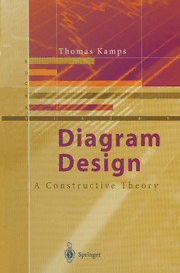
Diagram design [electronic resource] : a constructive theory PDF
Preview Diagram design [electronic resource] : a constructive theory
Diagram Design A Constructive Theory Springer Berlin Heidelberg New York Barcelona HongKong London Milan Paris Singapore Tokyo Thomas Kamps Diagram Design A Constructive Theory With 84 Figures, 8ofthem in Colour , Springer ThomasKamps HeidelbergerLandstr. 224A D-64297 Darmstadt, Germany ISBN-13: 978-3-642-64247-0 Springer-VerlagBerlinHeidelbergNewYork LibraryofCongressCataloging-in-PublicationDataappliedfor DieDeutscheBibliothek-CIP-Einheitsaufnahme Kamps,Thomas:Diagrammdesign: aconstructivetheory/ThomasKamps. Berlin;Heidelberg;NewYork;Barcelona;HongKong; London;Milan;Paris; Singapore;Tokyo: Springer, 1999 ISBN-13: 978-3-642-64247-0 e-ISBN-13: 978-3-642-60081-4 DOl:10.1007/978-3-642-60081-4 Thisworkissubjecttocopyright.Allrightsarereserved,whetherthewholeorpart ofthe materialisconcerned,specificallytherights oftranslation,reprinting,reuse ofillustrations,recitation,broadcasting,reproductiononmicrofilmorinanyother way, and storage indatabanks. Duplication ofthis publication orpartsthereofis permittedonlyundertheprovisionsoftheGermanCopyrightLawofSeptember9, 1965, in its currentversion, and permissionforuse mustalways beobtained from Springer-Verlag.ViolationsareliableforprosecutionundertheGermanCopyright Law. ©Springer-VerlagBerlinHeidelberg 1999 Softcoverreprint of the hardcover1stedition1999 Theuseofdesignations,trademarks,etc. inthispublicationdoesnotimply,evenin theabsenceofaspecific statement,thatsuchnames areexemptfrom therelevant protectivelawsandregulationsandthereforefreeforgeneraluse. Coverdesign: Kunkel+Lopka,Heidelberg Typesetting: Computertofilm fromauthor'sdata Printedonacid-freepaper SPIN 10703650 33/3l42PS 5432 10 Preface ToFarahandChiara Diagrams are known as grapical visualisations offacts. Someofthem, e.g., bar charts,pie-chartsornetworkdiagramsrepresentwellestablished,conventionaldi agramtypesthataregivennames. Indefinitelymanyunconventionaltypesexist derivativesofthose mentionedbefore, intermediary types, orjustnovel typesof visualisations createdby information designers. They m"ay be in 2-D or in 3-D space, using colours or grey~scale,representing temporal, geographical, orother aspects. Whatever the aspects they differ in, all ofthem haveonething in com mon: toalargeextenttheirconstructionobeysformalrules. Themainpurposeof this bookis to capturetheserules, analysethemand providea formal theory for diagramdesignthatservesasabasisforautomaticdesignapproaches. Automaticdiagramdesignisbecomingmoreandmoreimportant,especiallywhere on-demandgenerationofgraphicsisinevitable. Amajorfieldofapplicationcer tainly is the enormously growing field ofknowledge management. Knowledge, besidescapitalandlabour,hasinrecentyearsbecomeamoreandmoreimportant factor ofproductivity. Knowledge occursinmanybusinesscontexts,e.g.,as do main knowledge, as expertknowledge concerning themodellingofwork-flows, astechnologicalexpertisethatcompaniesneedtopreserve,butalsointheformof customerdatabases. Inanycase,theparticularknowledgeneedstobeaccessedto becomeoperational. Thisiswherediagramgenerationmayplayamajorsupport ingrole,sinceanimportanttypeofknowledgerepresenationarefacts,mathemat icallyexpressedbymeansofrelations. Inthisbooktheapplicationscenarioisconcernedwithanelectronicencyclopaedia ofartconsistingofadomainknowledgebaserepresentingobject-relations (ase manticindex). Theobjectsconnectedbytherelationsareart-specificentitiessuch as 'artists', 'works ofart', 'artisticprofessions', abstractconcepts suchas 'mod emart',or 'architecture',butalsoobjectsacting ascontainersfor textandimage materials. Thesemanticrelationsconnectingtheseentitiesare givenin theform ofevents, butalsoas instances ofthesaurus relations. Inthis way, all knowledge particlesaremutuallyinterconnectedandstructuredinalargesemanticnetwork. Supposeaquerytool,beingabletoretrieveinformationfromtheknowledgebase VI Preface by extracting subsets ofthis network, would be usedfor interactive data explo ration. Inthiscase, generateddiagramsmightbetheoutputofthequery. This, in tum,couldbethestartingpointforthesucceedingquery- inthiswayestablishing adiagram generation-based graphical explorationprocess. A bottleneckin such a model wouldcertainly berelated to thefact that the outputstructurescould be veryheterogeneous. Thisiswhyaratherflexiblegenerationprocess,thattakesthe differentdatacharacteristics intoaccount,wouldbea greathelp. Theart-centered scenarioin thisbookrepresents,ofcourse,only oneimpressive exampleapplicationforthecombinationofknowledgeanddiagramvisualisation. Otherapplicationcontexts mightberelatedtodata miningproblems where large amountsofrelationtuplesneedtobeclassifiedanddrilleddownsothat,e.g.,mar ketingexpertsgainmoreinsightintocustomerbehaviour. Inasimilarway,graph ical analysis ofweb-site related logfiledata might be a fruitful field ofapplica tion. Beyondthat,ahigh-leveldiagramsystemcouldbecomeadesignassistantin adesktop-publishingsystem. With suchasystema usercouldautomaticallypro duceasetofalternativedesignswithinareasonableamountoftime. Chapter 1will giveashortintroductiontotheproblemandchapter2 will discuss relatedworksandtheories. Chapter3willdefinetheterminologyforthedatastruc ture, followed by an example-driven motivation ofthe theory and algorithms in chapter4. Chapter5willdiscussdatacharacteristicsrelevantforthedesigns,where as chapter6 will outlinehow such data characteristics may betranslatedinto vi sual encodings givencomplex structures offacts. Chapter7 will accountfor the realisationsofthegraphicalencodingsusingprocedurallayouttechniquesandfor thesystemEAVE(ExtendedAutomaticVisualisationSystem)thatprototypically implementsthediagramdesigntheory. Chapter8willprovideasummaryandcon clusioIls. Thanks to all those people who helpedmeinproducingthisbook. Firstofall, I want to thank my wife for all thepatienceand support without which this work hadnotbeen:possible. Then,lowea greatdealto Dr. E.J. NeuholdandDr. J.D. Foley who made many valuable criticsms and suggestions throughouttheentire preparation ofthis book. I would also like to thankDr. R. Steinmetz who sup portedmeinmovingforwardduringthefinalphaseofpreparation. Agreatmany thanks,toallcolleaguesofmyformerGMD-IPSIdepartmentPaVEandtothede partmentCOMET, especiallytoKl Reichenberger, Dr. J. Batemanand C.Huser whoproofreadmany versionsofthemanUscriptanddiscussedthousandsofrele vantissuesconcerningdiagramgenerationandrelatedtopics. K. ReichenbergerandIhopeto tum asmanytheoreticalresults aspossibleprag maticallyintotechnologywithintheframeworkofourknowledge-basedvisualisa tionfocussed companyIntelligentViewsSoftwareandConsultingGmbH(http:// ww,w.i-views.de). Summer1999 ThomasM. Kamps Contents 1 Introduction 1 1.1 HistoricalReviewofPublishing 2 1.2 ThePublicationProcess ... 4 1.3 ThePublicationEnvironment 4 1.4 TheProblem 6 1.5 ASolution 7 1.6 Overview .. 8 2 Related WorkinAutomaticDiagramDesign 9 2.1 ConstructiveDecision-BasedDesignApproaches 10 2.1.1 Bertin'sApproach ........ 10 2.1.2 Mackinlay'sApproach ... 12 2.1.3 TheApproachofRothet.al. 13 2.1.4 Casner'sApproach ..... 14 2.1.5 TheApproachofMittaletal. 15 2.1.6 Marks'Approach . . . . . . . 16 2.1.7 TheApproachofReichenbergeret.al. 17 2.2 SummaryandDiscussion .................. 18 3 DataStructure 21 4 IntroductionTotheApproach 29 4.1 HowtoEstablishExpressiveness . 30 4.1.1 InexpressiveVisualisations 40 4.2 HowtoEstablishEffectiveness. . . 40 4.2.1 TaskandDataAspectsofEffectiveness 42 4.2.2 PerceptualAspectsofEffectiveness 43 4.2.3 Graphical AspectsofEffectiveness 44 4.3 ConflictsinGraphicalResourceAllocation 45 4.4 Summary andDiscussion ................. 46 vrn Contents 5 Relation Classification 49 5.1 BinaryRelationClassification · . 51 5.1.1 RelationTypes . 52 5.1.2 SummaryofBinaryRelationClassification 67 5.2 Classificationofn-aryRelations 69 5.2.1 FunctionalDependencies 70 5.2.2 NestedDependencies 76 5.2.3 ClassificationAlgorithmfor n-aryRelations 80 5.2.4 Summaryofn-aryRelationClassification 85 5.3 ClassificationofObjectNetworks 86 5.3.1 SharedDomainDependencies 86 5.4 Summary ofRelationClassification 90 6 GraphicalMapping 91 6.1 GraphicalBinaryRelations . .. 92 6.2 GraphicalBinding -.. . 110 6.2.1 ExpressivenessandEffectivenessofGraphicalBinaryRe- lations · . 113 6.3 VisualisationStrategiesforn-aryRelations .. 114 6.3.1 VisualisationofFunctionalDependencies 116 6.3.2 ResourceAllocationAlgorithmforFunctionalDependen- cies. . . · . 122 6.3.3 VisualisationofSet-ValuedFunctionalDependencies 128 6.3.4 ResourceAllocationAlgorithmforSet-ValuedFunctional Dependencies . . . . · . 131 6.3.5 VisualisationofMixed Functional and Set-Valued Func- .. tionalDependencies 133 6.3.6 ResourceAllocationAlgorithmforMixedDependencies 137 6.3.7 VisualisationofGeneral(Nested) n-aryRelations 139 6.3.8 ResourceAllocationAlgorithmfor Nestedn-aryRelations 144 6.3.9 VisualisationStrategiesfor ObjectNetworks . 148 6.4 SummaryofGraphicalMapping · . 150 7 LayoutandImplementation 153 J 7.1 Layout .. 153 7.1.1 ProcessingtheEncodingStructure . 153 7.1.2 ProceduralLayoutTechniques 155 7.2 Implementation 158 7.2.1 Object-OrientedDesign 158 7.2.2 DataObjectClassesandDataRelationClasses 159 7.2.3 ContextandLatticeRepresentations . 159 7.2.4 RelationTypesandRelationTypeLattice 161 CONTENTS IX 7.2.5 GraphicalElements .. . . . . . . . . . . . . . 163 7.2.6 TheThreePhasesoftheVisualisationAlgorithm 164 7.3 SummaryofLayoutand Implementation. . . . . . . . . 166 8 Conclusions 167 8.1 SummaryandResults 167 8.2 Cpmparisonwith theStateoftheArt. . . . . . 170 8.3 MoreApplicationAreasforEAVEComponents 171 8.4 InterestingUnsolvedProblems. . . . . . . . . 172 Bibliography 174 A DefinitionofRelational Properties 181 B RelationTypeConcepts 183 C Quantitative-PerceptualLimitationConstants 187 D ColouredIUustrations 189
